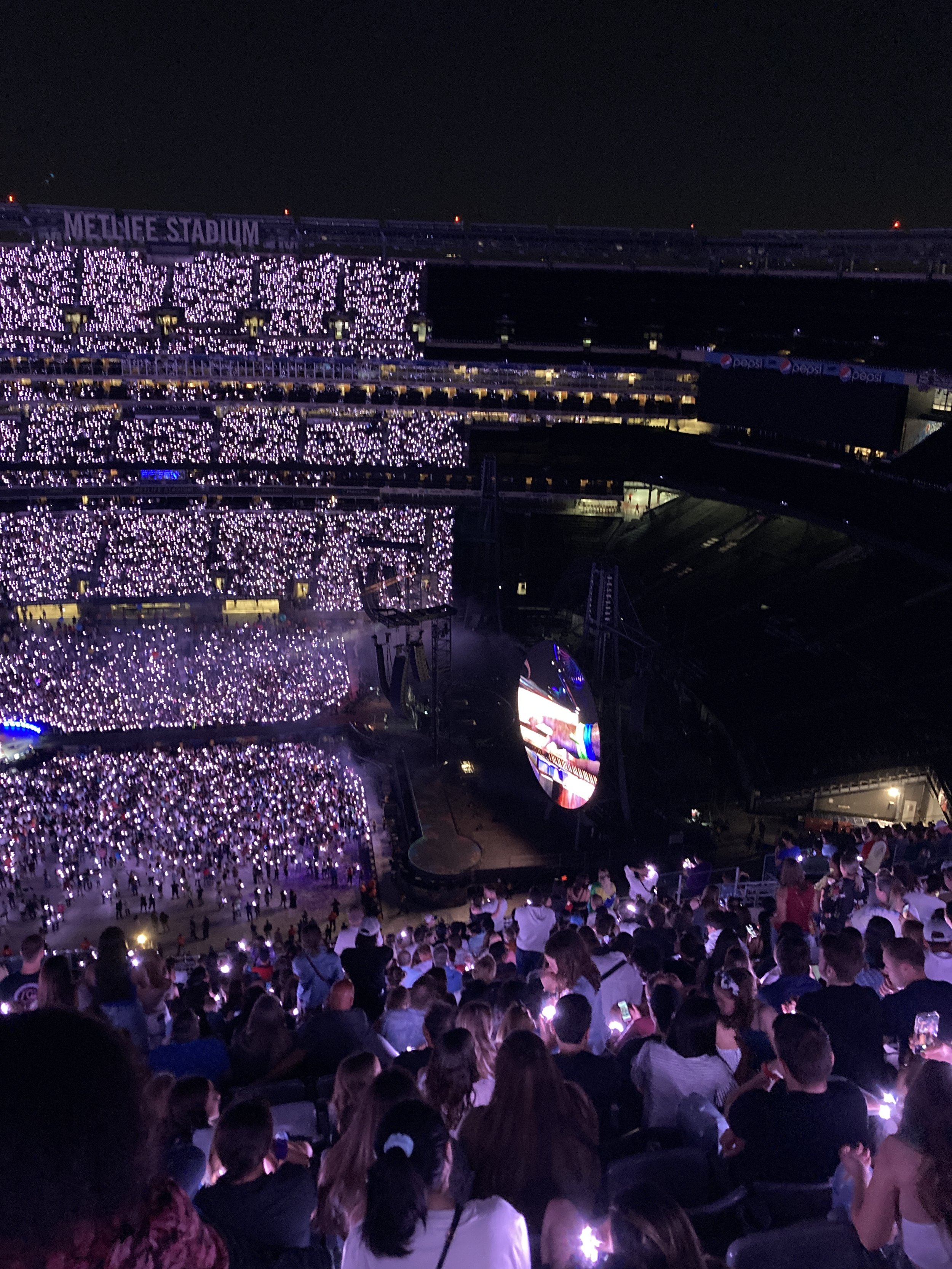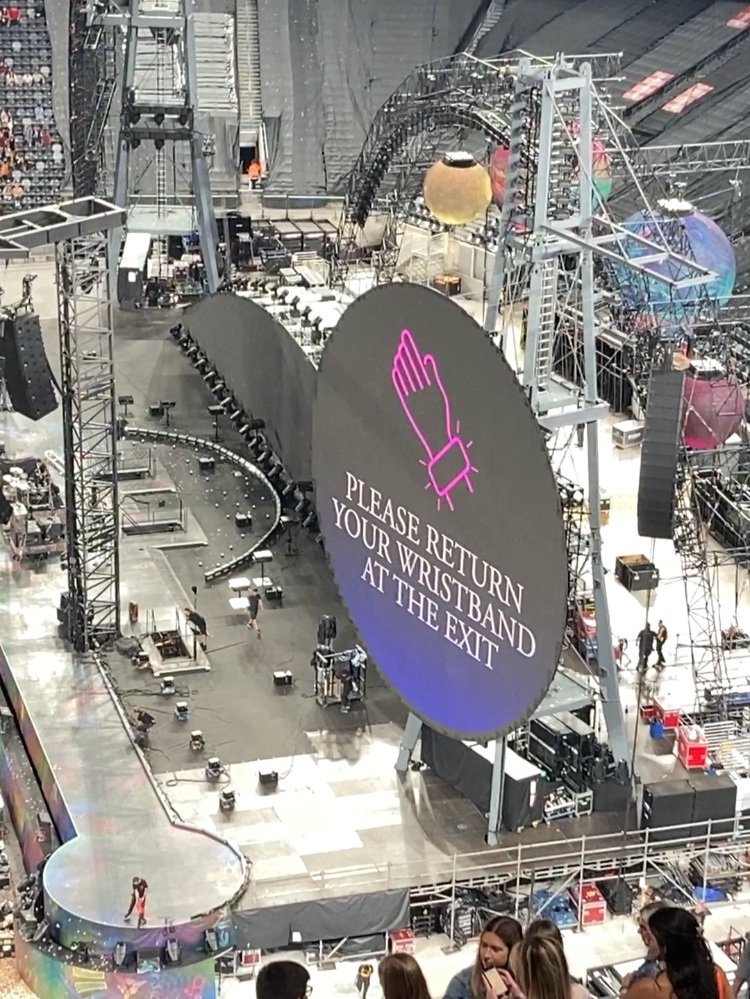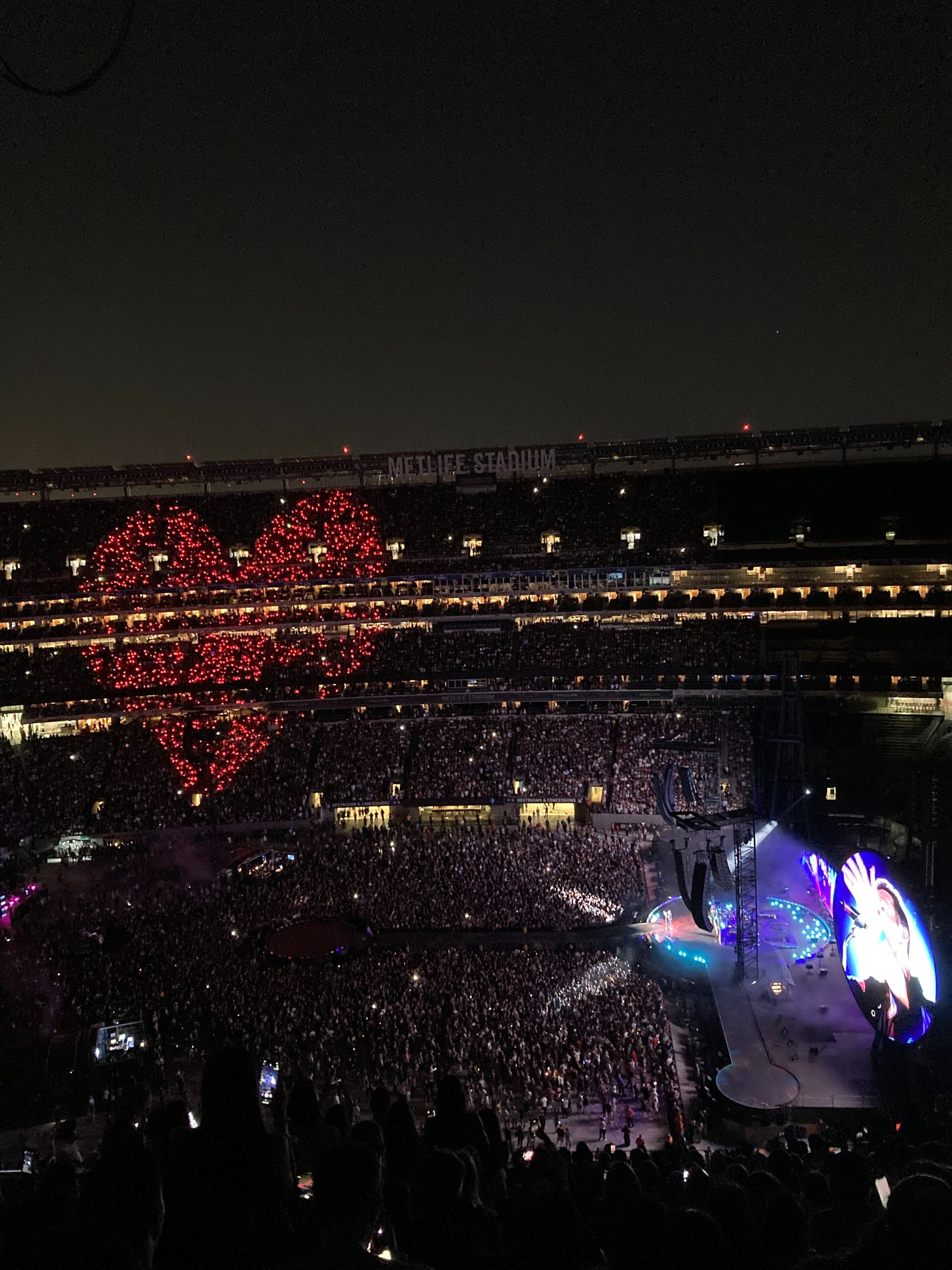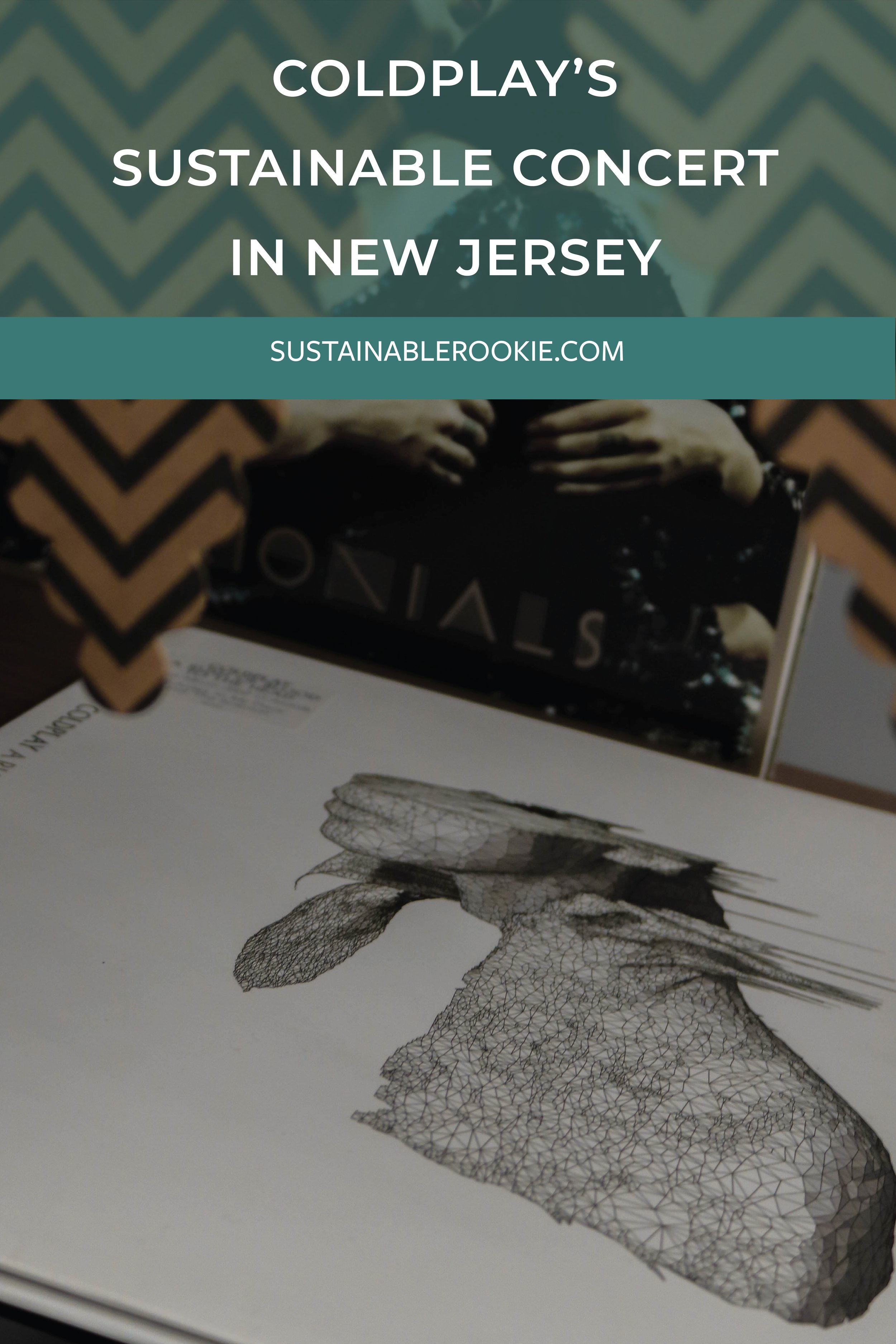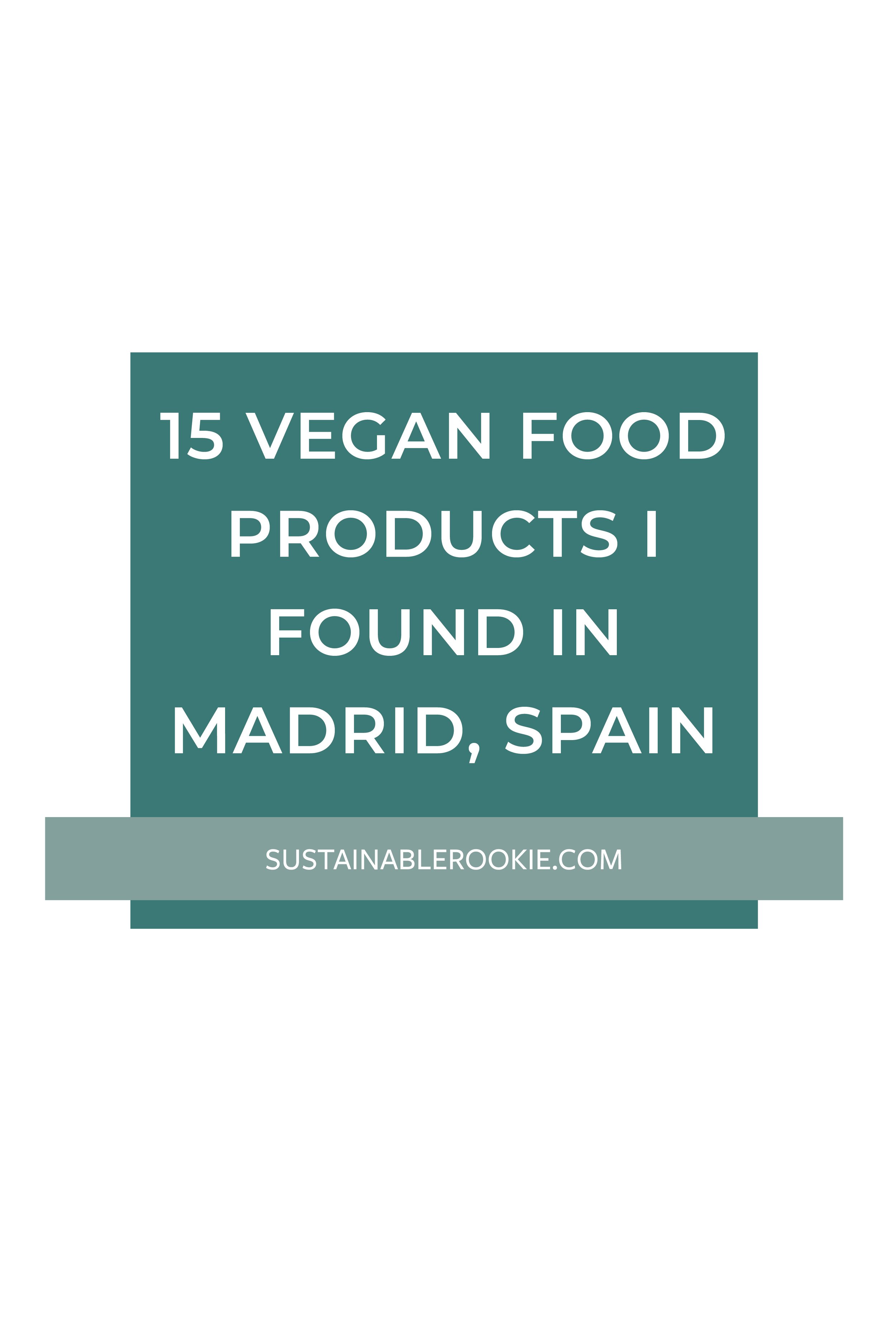Coldplay's Sustainable Concert in New Jersey
One of the activities I enjoy the most is going to concerts. I have been lucky enough to go to many, and so far, I had considered Coldplay’s concert in Buenos Aires in 2017 to be my favorite one. Their charisma is contagious, the lights in the show make it a beautiful scenery, like watching a Christmas tree light up but multiplied by thousands, and when you add in their music to the mix, the whole experience intensifies and goes straight into my heart, and it becomes pure emotion. Feeling the music live and sharing it with an audience–thousands of people gathered for one unique purpose, and to enhance what is already magical–is irreplaceable.
It didn’t come as a surprise then, that when they announced their 2022 tour, I was curious, but mostly impressed at their sustainability statement. I saw a video of Christ Martin on Instagram, where he talked about how they didn’t want to do a tour again until they found out a way of making it more sustainable, and this was the big breakout. There weren’t any dates announced in Miami, but I noticed one in New Jersey, not far from Manhattan, where a friend lives, and I visit her occasionally. We combined both trips–the concert and the visit– and my friend, my sister, and me, bought the tickets.
We missed the H.E.R. show before because we were napping (as pathetic as it sounds, but it was a well-needed rest after so much walking in the Big Apple), so we left my friend’s apartment later than we should have. We got just in time for Coldplay.
WHAT IS COLDPLAY DOING TO HAVE MORE SUSTAINABLE CONCERTS?
In 2019, Coldplay gathered a team of experts on sustainability to analyze the band’s environmental impact and carbon footprint. This way, they identified key areas of improvement. It’s important that they relied on expert hands, as it validates and legitimizes their efforts, but that’s not the only thing that makes it a valuable pledge. Coldplay also committed to an ongoing measurement of the environmental impact of this more sustainable tour, to be able to make further improvements. To assume a transparent position, they work in partnership with climate change experts at Imperial College London’s Grantham Institute–Climate Change and the Environment, to study and publish their progress. The fact they relied on experts and that they measure both the good and the bad, distances them from a greenwashing standpoint. Nonetheless, what I liked the most about their pledge is that they don’t claim to be doing everything perfectly, but better, and I always support progress over perfection. Coldplay is open to feedback and to make it even better in the future, and that’s a smart and realistic position to take.
Coldplay works on cutting emissions
Coldplay pledged to cut emissions by 50% from their previous tour, which also meant working with partners and suppliers so they can also make improvements. They also pledged to drawdown more Co2 than the tour produces, and this is done by supporting different projects related to the environment, like reforestation, rewilding, conservation, carbon capture and storage, soil regeneration, and renewable energy. For instance, from funds from the tour, they will plant and protect millions of new trees, which includes one tree for every ticket sold.
One of the ways in which they reduce emissions is by minimizing air travel. However, when flights are necessary (they are touring Europe, for instance), they choose commercial over charter. For both, they pay a surcharge to supply Sustainable Aviation Fuel (for own use or for others), which helps reduce greenhouse gas emissions of air travel by up to 80% compared to the conventional fossil jet fuel. They also opt for trains and electric vehicles when they have the chance for ground transportation. As for the trucks they use for the tours, they are powered by renewable fuel. Moreover, the tour has been carefully routed to minimize air travel.
Furthermore, Coldplay partnered with SAP to develop a free tour app to encourage fans to use low-carbon transport to and from shows, incentivizing its use by offering a discount code. Afterwards, with the information from the app, they calculate the total carbon footprint of their travel, and they pledged to drawdown these emissions via nature-based solutions like rewilding and conservation.
I downloaded the app and measured the impact of my trip. I flew from Fort Lauderdale to New York, so I know that has a big environmental impact; then we shared a taxi with my sister and my friend (in this case, only one of us should add the taxi option, probably my friend from New York), and we came back to my friend’s home in Manhattan by riding two trains. So, when I clicked on flight, specifying Fort Lauderdale to New Jersey, it estimates I used 634.04 kg of carbon, meaning they will plant 2.54 trees to mitigate my footprint. Then, it gives a few tips for this kind of transportation, like choosing direct flights, which reduces the carbon footprint, choosing a committed airline that displays CO2 calculations for flights, and taking a greener local transport.
The app also has games with an environmental twist. For example, there is one in which you must catch drops of water with an aluminum water bottle to save water; another one where you “pedal” to produce energy; and I also noticed there is one that is “Coming Soon”, in which you create kinetic energy as you run to the show.
Coldplay is relying on Renewable Energy for their concerts
In addition to these promises, the tour is powered by renewable energy from various kinds. For instance, they install solar photovoltaic panels; they also use renewable diesel made from hydrotreated vegetable oil, produced from renewable raw materials, mostly waste and residues, like used cooking oil, which, for example, runs the backstage generator and powers large parts of the transports used during the tour, contributing to a reduction in emissions. Also, the show batteries they use are recyclable and rechargeable with renewable energy (cooking oil, solar energy, wind, or kinetic energy).
The kinetic energy is the most fun to me! It is obtained from the kinetic floors they install at the stadium, where fans can dance and jump and convert this movement into energy to power the show. Moreover, there are pedal bikes that generate electricity when they are ridden by attendees. So, the more excited you are about the show, the more the batteries get charged! I spotted both the floors and the bikes from where I was (a hundred miles from the stage), and they were located at the ground level area. They even had contests to see which group of fans can generate the most power. A great way to get everyone involved, isn’t it?
Coldplay’s Wristbands and Sustainability
Besides the amazing music and charisma from Coldplay’s band members, what makes the show truly unforgettable are the wristbands, which differentiate the concert from other artists. When you put a wristband that synchronizes its light to the rhythm of music on 60,000 people, you get magic. I truly admire the people who conceived this and work on this task to achieve that synchronization. The color of the lights changes and by turning them on and off, they match it to the beat of the song that’s being played. For example, for the song Yellow, all wristbands turned yellow. At one moment, they made a heart out of a group of people, so I guess they have geo-localization settings too.
These LED wristbands are made from a plant-based plastic that is also compostable. The material is sourced from renewable sugarcane that is grown under a Supplier Code of Conduct and that has zero deforestation impact or displacement of food supply. Even better, the processed PLA plastic used in the 7-LED wristbands has a carbon footprint that is 400% lower than regular plastic (PET) at 500 kg Co2 eq./ton polymer. At 17 grams of PLA plastic in each 7-LED wristband, the total emissions for one million units are estimated at 8,500 kg Co2 eq., which, according to US EPA, is equivalent to 1.8 car driven for a year, and can be sequestered by 141 trees grown for 10 years.
Attendees are asked to return them at the end of the show. By collecting, sterilizing, and recharging them, they reduce wristband production by 80%. The electronic components are later repurposed for wristbands that will be used in future tours. At the end of the product’s life, the plastic casing is removable and decomposes after 2 months in an industrial composter, or 2 years in regular compost.
More Sustainable Stage, Lighting, Audio, and Special Effects
Coldplay’s sustainability efforts involved everything that goes into making each concert of the Music of the Spheres tour an unforgettable experience. These measures also reached the stage, which for this tour is built from eco-friendlier materials that are also reusable, which includes recycled steel.
As for the lighting, they use low-energy LED screens laser and lighting system, and a PA system with up to 50% less power consumption in comparison to the previous tour. It also reduces environmental noise outside the venues.
For special effects they used confetti that requires less compressed gas for ignition than previous tours. They also claim it’s biodegradable, although I didn’t find information on how long it takes to biodegrade or under what conditions.
What I was very skeptical about was the fireworks, which they started using after the first few songs. I was a bit disappointed (although it didn’t stop me from having an incredible time), because fireworks are anything but sustainable. However, after looking into it after the show, I found that even the pyrotechnics they use have less explosive charge and less harmful chemicals. Nonetheless, in my opinion, they could definitely be avoided next time, as the show would have still been amazing without them.
Coldplay’s sustainable pledge includes water
Coldplay took a few initiatives to save the most precious gift this earth has given us: water. Water scarcity is one of the biggest problems we face in the environmental area. At least 1.1 billion people don’t have access to water and 2.7 billion experience water scarcity at least one month a year. It is estimated that by 2025, two-thirds of the world's population may be facing water shortages. Thus, water had to be included in their pledge.
They asked venues to introduce aerated taps, low flushing toilets, and to reduce water pressure to decrease water wastage. Also, they made sure to have water refill stations for the fans, who were encouraged to bring their own reusable bottles. This way, they got the venues and the fans involved as well.
A more sustainable approach to Food, Beverages, and Merchandising
The show in itself is more sustainable, but what about fans consumption habits once they are at the venue?
What I noticed was that they didn’t sell single-use plastic water bottles, as they replaced them with aluminum (I think the brand they used, at least in New Jersey, was PATH). Moreover, they introduced Ball aluminum cups for the same purpose. This is a great improvement in their sustainability actions, as aluminum is more easily recycled than plastic, can be recycled infinitely (plastic can’t), and uses less energy in doing so. Besides, the aluminum water bottle can be reused, being stronger and more durable than single-use plastic. For fans who wanted to buy a souvenir from the concert, with an eco-friendlier approach, they had custom-designed reusable water bottles made of 90% recycled content (the highest recycled content rate of any beverage packaging in its category), in partnership with Miir, a company which also pledged to donate to ClientEarth, The Ocean Cleanup North Pacific Foundation and One Tree Planted. Recycling one ton of aluminum (expected for this tour) has three times the greenhouse gas reduction benefit compared to recycling other packaging materials. This way, they reduce single-use plastic consumption, by also encouraging recycling and reusing. Regarding this, Coldplay also worked with each venue to encourage them to establish recycling programs within the stadium.
Coldplay also included plant-based and meat-free options as standard in their catering menus for their Music of the Spheres tour, besides supporting the development of synthetic, lab-grown cultured foods. This is because plant-based diets are more sustainable than animal-based diets, or even vegetarian diets. They partnered with local food banks to donate surplus food, and they will compost organic waste when possible.
In terms of merchandising, they offer sustainably and ethically sourced options, and replaced plastic fabrics with more natural alternatives. The merchandise is packaged in recycled paper or compostable bags, instead of plastic.
Coldplay supports Good causes
Coldplay pledged to put 10% of everything they earn, including the tour, records, and publishing, into a good-causes-fund, which is split between environmental and socially conscious projects and charities, like ClientEarth, The Ocean Cleanup, and One Tree Planted, working in partnership with EarthPercent as a founding donor. By sponsoring The Ocean Cleanup, they help clean up waste beyond the concerts, by supporting river interceptors that remove thousands of tons of garbage from some of the most polluting rivers around the world, blocking their way into the ocean.
Besides Ocean Cleanup, they support ocean conservation and the protection of marine species, seagrass meadow restoration, and management of seaweed blooms.
Additionally, the tour will fund the planting and protection of millions of new trees, which includes one tree for every ticket sold. Because biodiverse landscapes sequester up to 80% more Co2 because of their soil structure, they promised to avoid mono-culture plantations. So, basically, if you attended a Coldplay concert, there will be a tree existing in your honor!
I love that they put focus on soil health as well, another key aspect in the environmental world. They pledged to support positive soil restoration projects that regenerate land, promote biodiversity, and sequester millions of tons of Co2. Also, investing in projects that restore degraded and marginal land to its natural uncultivated state, in order to promote biodiversity, capture Co2 emissions, and provide support for ecosystems.
Coldplay also supports MyTrees Trust/Miti Yangu in Zimbabwe, a community-led project that protects wilderness and supports the regeneration of forest, providing a habitat for critically threatened wildlife; and Sea Shepherd, in their attempts at stopping the damaging effects of overfishing and the threats to marine wildlife. At the concert, they also mentioned carbon capture, green and clean tech, environmental law, and advocacy.
They also pledged to work with Green Nation (Live Nation’s sustainability platform), as a special artist advisor to ensure sustainable practices that were developed for the Music of the Spheres tour are shared, adopted, and scaled throughout the rest of the industry.
A bit of Backlash from skeptics
Unfortunately, as with everything, Coldplay received some backlash. I guess nobody can escape the scalding tongues of the crowds, which is ironic, because I don’t hear anyone backlashing artists who don’t do anything about sustainability, only those who are trying their best. Albeit I understand the need to be careful about greenwashing, I believe this can be counterproductive and demotivate instead of encouraging them.
Coldplay was accused of greenwashing because it partnered with Neste, which calls itself the world’s largest producer of sustainable biofuels. However, this company has been linked to deforestation and dubious biofuels, like palm oil. Their palm oil suppliers cleared at least 10,000 hectares of forest in countries like Indonesia and Malaysia between 2019 and 2020. The company said they didn’t use conventional palm oil for their collaboration with Coldplay, and that they plan on ending its use by 2023.
Criticism also arose from another collaboration from the tour, the one with BMW for the rechargeable electric vehicle batteries used to power the shows, a company that has been lobbying to prevent the EU from setting a deadline for 2035 for vehicles to be zero emissions only. In response, Coldplay said they had approached other electric car manufacturers, but BMW was the one that offered to help, and that they don’t have any connection or influence on their corporate policies, they just wanted the batteries.
As I mentioned at the beginning, Coldplay has been super transparent and honest about how they are trying the best and are open to suggestions on how to be better. They have stated from the start that they were trying to make it as sustainable as possible, but it would be a work in progress, with lots of room for improvement. The greenwashing accusations because of these two collaborations are ridiculous to me. Let’s focus on encouraging good actions and ask for change to those who aren’t doing a single thing!
This is what Coldplay is doing to make their concerts more sustainable! What do you think? Would you like to go to one of their shows? They are so cool that they sold out 10 entire stadiums in my hometown (Buenos Aires). How crazy is that!


